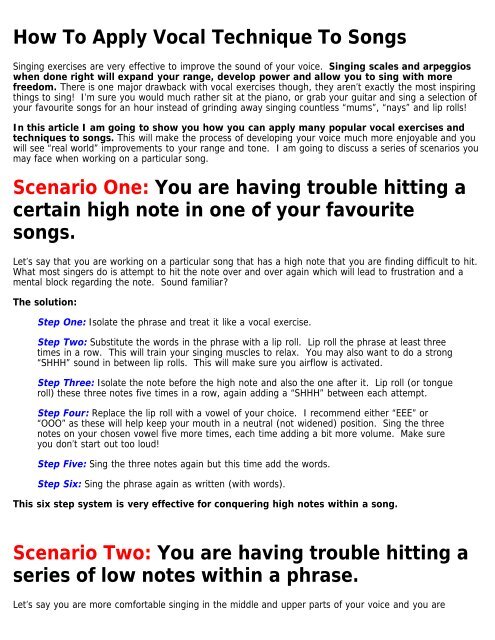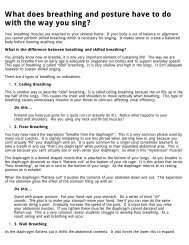How To Apply Vocal Technique To Songs - How To Sing With ...
How To Apply Vocal Technique To Songs - How To Sing With ...
How To Apply Vocal Technique To Songs - How To Sing With ...
You also want an ePaper? Increase the reach of your titles
YUMPU automatically turns print PDFs into web optimized ePapers that Google loves.
<strong>How</strong> <strong>To</strong> <strong>Apply</strong> <strong>Vocal</strong> <strong>Technique</strong> <strong>To</strong> <strong>Songs</strong><br />
<strong>Sing</strong>ing exercises are very effective to improve the sound of your voice. <strong>Sing</strong>ing scales and arpeggios<br />
when done right will expand your range, develop power and allow you to sing with more<br />
freedom. There is one major drawback with vocal exercises though, they aren’t exactly the most inspiring<br />
things to sing! I’m sure you would much rather sit at the piano, or grab your guitar and sing a selection of<br />
your favourite songs for an hour instead of grinding away singing countless “mums”, “nays” and lip rolls!<br />
In this article I am going to show you how you can apply many popular vocal exercises and<br />
techniques to songs. This will make the process of developing your voice much more enjoyable and you<br />
will see “real world” improvements to your range and tone. I am going to discuss a series of scenarios you<br />
may face when working on a particular song.<br />
Scenario One: You are having trouble hitting a<br />
certain high note in one of your favourite<br />
songs.<br />
Let’s say that you are working on a particular song that has a high note that you are finding difficult to hit.<br />
What most singers do is attempt to hit the note over and over again which will lead to frustration and a<br />
mental block regarding the note. Sound familiar?<br />
The solution:<br />
Step One: Isolate the phrase and treat it like a vocal exercise.<br />
Step Two: Substitute the words in the phrase with a lip roll. Lip roll the phrase at least three<br />
times in a row. This will train your singing muscles to relax. You may also want to do a strong<br />
“SHHH” sound in between lip rolls. This will make sure you airflow is activated.<br />
Step Three: Isolate the note before the high note and also the one after it. Lip roll (or tongue<br />
roll) these three notes five times in a row, again adding a “SHHH” between each attempt.<br />
Step Four: Replace the lip roll with a vowel of your choice. I recommend either “EEE” or<br />
“OOO” as these will help keep your mouth in a neutral (not widened) position. <strong>Sing</strong> the three<br />
notes on your chosen vowel five more times, each time adding a bit more volume. Make sure<br />
you don’t start out too loud!<br />
Step Five: <strong>Sing</strong> the three notes again but this time add the words.<br />
Step Six: <strong>Sing</strong> the phrase again as written (with words).<br />
This six step system is very effective for conquering high notes within a song.<br />
Scenario Two: You are having trouble hitting a<br />
series of low notes within a phrase.<br />
Let’s say you are more comfortable singing in the middle and upper parts of your voice and you are
working on a song that has a series of low notes in a verse. You find that your voice gets “stuck” and<br />
unable to sing the notes with any volume.<br />
The Solution:<br />
Step One: Isolate the phrase and treat it like a vocal exercise.<br />
Step Two: Do three strong “SHHH” sounds. Low notes allow more air to pass the through the<br />
vocal cords so you need a consistent flow.<br />
Step Three: Speak the phrase. Your speaking voice uses the same vocal structure as you<br />
chest voice. Now try and speak the phrase “on pitch”.<br />
Step Four: Replace the words with an “AHH” vowel. Try and maintain the same tone as when<br />
you were speaking the phrase. Put your hand on your chest and make sure that you are feeling<br />
vibration in your chest cavity while doing this exercise.<br />
Step Five: <strong>Sing</strong> the phrase again adding the words.<br />
This is a great five step system for accessing you chest voice. When doing these exercises<br />
make sure you keep a tension free throat. It will allow your sound to descend much easier.<br />
Scenario Three: You are having trouble<br />
sustaining a phrase which sits right in the<br />
middle of your voice.<br />
Let’s say that the chorus of a song you are working on has a series of notes which sit right in the middle of<br />
your voice. You find that your voice shifts between head voice and chest voice causing your tone to<br />
become very inconsistent. You have tried singing it with a louder volume but find that your voice tires<br />
quickly.<br />
The Solution:<br />
Step One: Isolate the phrase and treat it as a vocal exercise.<br />
Step Two: Replace the words of the phrase with a lip roll. This will help to keep your singing<br />
muscles relaxed and your larynx low. Do this three times.<br />
Step Three: <strong>Sing</strong> the phrase using the word “mum”. Do this three times adding a strong<br />
“SHHH” between each attempt.<br />
Step Four: <strong>Sing</strong> the phrase using the word “nay”. Do this three times adding a strong “SHHH”<br />
between each attempt. Try and add a crying sound to your “nay”.<br />
Step Five: <strong>Sing</strong> the phrase again adding the words. Try and maintain a crying sound to your<br />
tone.<br />
This five step system is great for singing in mixed voice. It is designed to train your muscles<br />
to stay relaxed and maintain a low larynx. The crying sound helps to shift resonance into the<br />
nasal cavity.
Scenario Four: You are told that your tone is<br />
“muddy” and your words are hard to<br />
understand.<br />
<strong>Sing</strong>ing is really just another form of communication. If your words and tone are not clear you will have<br />
trouble connecting with an audience. The following exercises and techniques will help to clear up your<br />
tone.<br />
Step One: Isolate the phrase and treat it as a vocal exercise.<br />
Step Two: Stick out your tongue and attempt to sing the phrase with as much clarity as you<br />
can. This will get your articulators (tongue, lips and jaw) working overtime. If you find that<br />
your tongue retreats back into your mouth move to step three.<br />
Step Three: Repeat previous exercise but hold your tongue with your fingers to stop it moving<br />
back into your mouth. The tongue is a major reason for most tone problems.<br />
Step Four: <strong>Sing</strong> the phrase again with words. Focus on making the words as clear as you can.<br />
You should find that your tone is greatly improved.<br />
This four step system for improving tone is a fantastic way to add clarity to your voice.<br />
Bonus Tips:<br />
Tip One: If you have a word that has two distinct vowels directly after each other, always make<br />
the first vowel longer than the second. This is called a diphthong.<br />
Tip Two: Always make the vowels in your words longer than the consonants. This will help<br />
create a very smooth tone. Having shorter vowels will create a choppy tone.<br />
Tip Three: If you are finding a high note pretty much impossible to hit try having a bit of fun<br />
with it. Siren on vowels “ee” and “oo” as high as you can. When you feel a bit more relaxed<br />
have a go at singing the high note again. Don’t take things to seriously. Have a bit of fun with<br />
your voice and notice the difference it makes to your energy.<br />
<strong>Sing</strong>ing exercises for hours on end can often be a boring and mundane task. By isolating<br />
phrases in your favourite songs and treating them as vocal exercises you will see instant<br />
improvements to your voice and have a bit of fun doing it!<br />
Ian Castle



